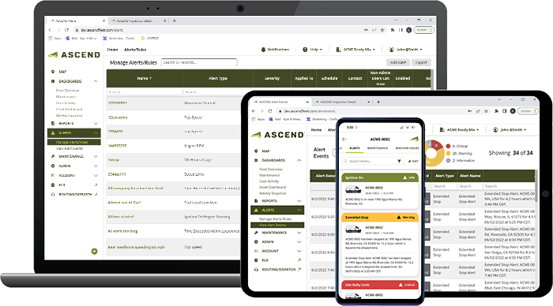Is your telematics solution optimized?
You've put in a lot of effort to grow and adapt your business to meet your customers' changing needs. From adding new equipment to expanding your team and improving operational processes, every move has been aimed at boosting efficiency, increasing revenue, and maximizing profitability. Along the way, technology has become a key partner in making your operations run smoother. Telematics technology, in particular, has been a major player, helping you optimize efficiency by using fleet data to simplify tasks, cut down on manual work, and gain valuable insights for smarter, more strategic decision-making.
Despite all your efforts to optimize and propel your business forward, is your telematics solution merely checking the box—providing basic functionality without keeping pace with your evolving business needs?
Certainly, your telematics system may have fallen behind in terms of innovation and adapting to your evolving needs. While it may still perform essential functions like creating daily routes or capturing ELD data for compliance, it likely isn't keeping pace with the changes in your fleet, team, and requirements. This poses a significant issue, particularly if you're not addressing the right questions about your telematics
Here are eight essential questions for businesses to consider when evaluating telematic solutions:
Has Your Telematics System Grown Obsolete?
Your telematics solution might be falling short for a couple of reasons. Firstly, consider the duration of its implementation in your business—how long have you been using the current solution? Three years? Five years? Even longer? As technology continually evolves, the hardware and software can become outdated, losing their effectiveness and blocking out new improvements due to the system's limitations and shortcomings.
Think of what happens with your cell phone or laptop computer. In time, performance slows, the device becomes less reliable, and it’s not compatible with new features and applications that you would find valuable, if not indispensable. Similarly, you might own an older television that still works fine, but it doesn’t offer the latest high-definition picture quality or the capabilities of a modern smart TV.
The longer you’ve had your telematics system, the more susceptible you are to it falling short of what you need it to do for your evolving business. If you are nearing the end of a standard three-year contract, now is a good time to assess how your business has changed and question if your telematics solution still delivers the value you need.
Another reason your telematics system may be out of step with your business is that many telematics companies – perhaps including your provider – don’t invest in innovation. They develop a workable product and then continue to sell it for years, making only minor or cosmetic updates – all the while falling behind the growing and changing needs of tech-savvy businesses like yours.
Those that do add features and capabilities may even take shortcuts by partnering with third parties or overhyping how their system meets a critical business need like installing ELDs on vehicles that don’t need them to just check the inspection box.
How to Evaluate Your Telematics Solution
All of this underscores the fact that you need to regularly evaluate your telematics technology and the value you are getting from your system. That evaluation boils down to determining if your telematics system gives you everything you need or if it simply “checks the box” when it comes to providing a solution, albeit an inferior one, to your fleet data and analytics needs.
To conduct that evaluation, here are eight telematics questions you should ask.
Is your telematics system a complete solution? This is probably the biggest question when it comes to the changing needs of your business. It’s especially relevant if you have a mixed fleet that includes everything from large over-the-road trucks to pick-up trucks, to trailers, to yellow iron, to cranes or generators, and more. Or, perhaps you even have multiple fleets, such as the case with a construction company that also operates a service business with a fleet of vans.
Whatever the mix of your vehicles and assets, you shouldn’t need multiple systems to get the full range of capabilities available through the right telematics system. You shouldn’t need separate systems for inspections, routing, dispatching, fleet analytics, and other capabilities. All these powerful features are available to mixed fleets in a single, up-to-date telematics system that can truly move your business forward.
Does your system have built-in inspection and maintenance modules that work together as one complete solution? Inspection and maintenance are both critical to the efficient operation of your fleet and to keeping your vehicles and equipment in service and generating revenue. In the right telematics system, you should be able to integrate them for maximum efficiency. Digital inspections and automated inspections are available to help minimize human error. With the right telematics system with fleet maintenance software, maintenance personnel can be alerted to repairs uncovered during inspection, increasing the efficiency of your maintenance team, and allowing you to minimize or better manage equipment-related downtime.
Does your system tie together routing and dispatch? Modern telematics systems draw on GPS technology to easily plan daily routes and deploy equipment and staff when and where they are needed. But managing the movement of a fleet doesn’t end there. Communication between dispatchers and drivers is the lifeblood of the daily operation of a service fleet. Through dispatch software, dispatchers should be able to communicate with drivers, and vice versa, through direct messaging via a mobile app, voice communication, alerts, and the sharing of photos and reports. Separate systems to facilitate communication shouldn’t be accepted as the only option.
 Can you see all your data in a single pane of glass?
Can you see all your data in a single pane of glass?
A huge shortcoming of an incomplete telematics system is that additional solutions are needed to get a complete picture of your fleet data. That means having to toggle back and forth between software platforms and, more crucially, the possibility of missing out on insights and intelligence that can make a real difference. For example, for your yellow iron, you might want to access utilization data and track fuel levels and engine RPMs. Meanwhile, for your vans, you might want to track idle time and productivity. In order get all this data on two different asset types, you could need to access two separate systems.
One of the biggest advantages of today’s best telematics systems is the ability to view all your fleet data in one place – on a single pane of glass. If your current system doesn’t allow you to do this, you probably want to begin exploring other telematics options.
Does your system provide the hardware flexibility you need for your entire fleet? If you have a mixed fleet, you will need different telematics hardware for different vehicles or assets. These can range from simple location trackers to complex engine bus data for yellow iron, to dashboard cameras to slap-and-track hardware for your small expensive equipment.
With the right telematics system, you can connect your entire fleet – no matter the asset type – to the telematics data platform to get a complete picture of fleet status, optimization, and performance. The telematics provider should have the expertise and capability to make it happen.
What support do you receive from your provider? Speaking of telematics providers, they need to offer a powerful solution while also being able to help you tailor it to your needs. They should help during implementation, assisting in planning the rollout and providing onboarding and training to your users.
Telematics support should include standing behind the system to fix problems and troubleshooting when things don’t work as expected. While this sounds obvious, it can become a major headache if the provider relies on third-party partners to deliver its solution, which can cloud who you need to call when issues arise, and you need answers fast.
How robust are your analytics? Even if you can access data on all the assets in your fleet, that data might not be as complete or useful as it could be. The right telematics system provider will offer the broad mix of hardware mentioned above and even allow you to get comprehensive performance data by tying into the engine bus to get valuable real-time data, such as RPMs and battery voltage, that will power high-level monitoring and analysis of your equipment and their utilization.
Fleet analytics with reporting functionality also is important in helping you access and interpret fleet data to drive better business decisions. If your telematics system won’t allow you to access the reports you most want to see, it’s an indicator that your system may not be the right fit with your business.
Does your solution cover all the bases? In the realm of telematics systems, there are several capabilities you should expect to see, and the list grows as the technology advances and the needs of businesses like yours expand. Among these capabilities are API integration, asset tracking, vehicle tracking, dashcams, ELDs, driver scorecards, fuel management capabilities, geofences, inspections, maintenance management, routing and dispatch, real-time alerts, and reporting.
While these are all now common capabilities, it’s worth pointing out that not all providers offer them as part of their solution. You should expect nothing less than this full range of features and functionality from your telematics solution as it relates to your specific business.
Don’t Settle for a System That Works
As this list of questions suggests, telematics systems have become increasingly indispensable to managing company fleets. In evaluating your system, you’ll want to be thorough in determining how it measures up against your business’ changing needs. Systems that merely check the box when it comes to features and capabilities won’t be the right answer. You need a telematics solution that delivers on the promise of the technology and is backed by a provider that can help you get the most out of it and that works to keep its solution on the leading edge through investment and business knowledge.
To manage your fleet, you need much more than a telematics solution that only checks the box. You need a telematics system that really works for you and your business.
Ready to learn more? Schedule a free demo to see the benefits of optimized telematics .

